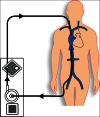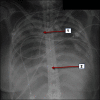Interhospital transfer of seriously sick ARDS patients using veno-venous Extracorporeal Membrane Oxygenation (ECMO): Concept of an ECMO transport team
- PMID: 23724385
- PMCID: PMC3665119
- DOI: 10.4103/2229-5151.109420
Interhospital transfer of seriously sick ARDS patients using veno-venous Extracorporeal Membrane Oxygenation (ECMO): Concept of an ECMO transport team
Abstract
Background: Extracorporeal membrane oxygenation (ECMO) therapy constitutes the last option for patients with acute respiratory distress syndrome (ARDS) refractory to conservative treatment. Since primary care centers are unable to provide this therapy, such patients need a transfer to a tertiary care center, which may be life-threatening without extracorporeal support.
Methods: An ECMO transport team implanted an ECMO at the site of the primary care center with subsequent transport of the patient to the tertiary care center. Between September 2009 and March 2011, six patients with ARDS were treated by our ECMO transport team. Mean age was 39.5±12.0 years. All implantations were done percutaneously in a veno-venous configuration.
Results: No complications occurred during the implant procedure and the subsequent transport. Four patients (67%) were successfully weaned from ECMO-therapy, and discharged from hospital.
Conclusion: With a specialized ECMO transport team, ECMO-implantation can be achieved successfully in a peripheral hospital, and patients can be transported safely.
Keywords: Acute respiratory distress syndrome; extracorporeal life support; extracorporeal membrane oxygenation; interhospital transfer.
Conflict of interest statement
Figures


References
-
- Champunot R, Tanjatham S, Kerdsin A, Puangpatra P, Wangsai S, Treebuphachatsakul P, et al. Impact of pandemic influenza (H1N1) virus-associated community-acquired pneumonia among adults in a tertiary hospital in Thailand. Jpn J Infect Dis. 2010;63:251–6. - PubMed
-
- Brun-Buisson C, Minelli C, Bertolini G, Brazzi L, Pimentel J, Lewandowski K, et al. Epidemiology and outcome of acute lung injury in European intensive care units. Results from the ALIVE study. Intensive Care Med. 2004;30:51–61. - PubMed
-
- Bersten AD, Edibam C, Hunt T, Moran J. Australian and New Zealand Intensive Care Society Clinical Trials Group. Incidence and mortality of acute lung injury and the acute respiratory distress syndrome in three Australian States. Am J Respir Crit Care Med. 2002;165:443–8. - PubMed
LinkOut - more resources
Full Text Sources
Other Literature Sources

